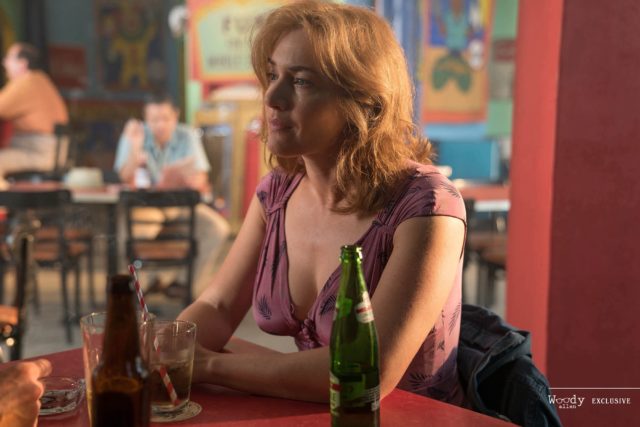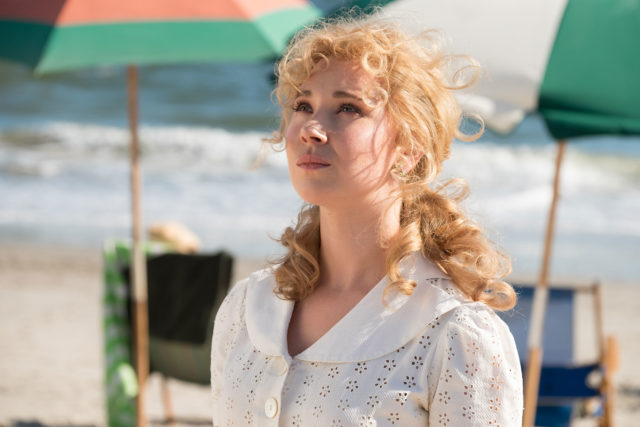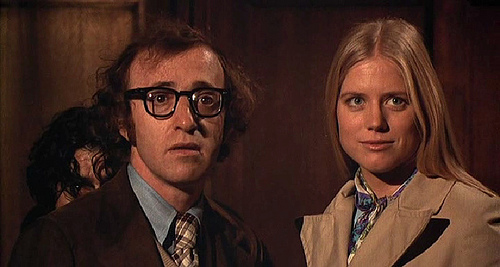
Wonder Wheel, the new film written and directed by Woody Allen, is due to premiere next week at the New York Film Festival. Press are scheduled to see the film next week, and now there is a new press kit for the film. It features lots of great information about the film, and thoughts from the cast.
Warning. Minor spoilers – although we’ve tried to pick the least spoiler-y quotes. You can find the press kit at the official Woody Allen site.
Allen on the Coney Island setting. (The press kit incorrectly identifies the rollercoaster in Annie Hall as the Cyclone. It’s actually the original Thunderbolt, which is now gone).
Its heyday was long before I was born, but when I went it was still pretty exciting. It always impressed me. There were so many colorful people there, and so many conflicting and complex activities going on, and it was such a vital atmosphere. I thought it would be a very provocative atmosphere to set a dramatic story in.
Allen on his strong female leads in his dramatic works.
I have always been attracted to problems that women have. Over the centuries, the guys tend to be less readily demonstrative about their suffering. The male code is to not show suffering. Like when a batter gets hit by a pitcher, the idea is not to show any pain. Whereas women have always been more open about their emotions. I’ve done mostly comedies, but whenever I’ve turned to a dramatic story, it almost always—not always, but almost—has been about women in critical situations.

On Kate Winslet.
I knew I needed a tremendous actress to play her. There are only a limited number of actresses in the English language that are that deep and that great. Kate Winslet is one of them, and when we started casting, her name came up quickly.
Winslet, on accepting the challenge of the role.
It was the responsibility of playing someone who was that complex, not wanting her to fall into a cliché in any capacity, always wanting to stay the right side of the line, keep her real, not have her become a caricature in any way at all, and absolutely to keep her grounded in her awful reality. Woody wanted to hire me and I had to step up to the plate and be the goods that he’d hired, and be the best possible version of those goods that I could find within myself.
Winslet on working with Allen.
If a scene was not going well Woody would go, ‘Stop, we’ve got to fix this’ and then he would say, ‘Now how do I direct you out of this hole I’ve written you into?’ We would laugh and then we would figure it out.

Allen on Justin Timberlake.
If these were the 1930s or 40s or 50s, he would have been right there with the Gables and the Bogarts. That would have been his milieu. He lights up the screen whenever you put the camera on him. Justin has it all.
Timberlake on Allen.
It’s fast and there’s not a lot of coverage. He does very long takes and you get about two to five shots at every scene. At first it was really intimidating, but, after awhile, I found it really freeing and fun, because I didn’t have to worry about matching what I did before. And this caused me to keep discovering things. I felt like I was acting in a play with a group of really gifted and talented actors beside me.

On Jim Belushi.
I could tell after five minutes with him, that he would make a wonderful Humpty. I think he will surprise a lot of people with this. I think they’re going to be surprised at what a tremendous actor he is, so full of emotion, full of reality and full of feeling
Belushi on Allen
Woody gives you a lot of room. I worked for three months before shooting, memorizing every comma in the script, but when I got to set he said, ‘These are writer’s words. You do what you want to make the words your own. In the end, I only changed a few things here and there, but he was lovely to work with, and very funny to be around.

Allen on Juno Temple.
Juno came through brilliantly for me. She is a very touching and real actress, and she had all the elements to play the character.
Temple on Allen.
The long, fluid scenes we did were choreographed like dances with dialogue, and he was very specific about where he wants people to land because of how it fills the frame. Sometimes he would just want you to move a foot to the left for a certain piece of lighting.
On cinematographer Vittorio Storaro.
Vittorio is a major contributor and genius cameraman, so anything we decide on, he’s always got some wonderful ideas for. It’s a treat to work with someone who makes such a gigantic theatrical contribution to the project.
Storaro found inspiration in the works of 50s American artist Norman Rockwell.
Rockwell presented a positive way of living during the 50s in the United States. Which was a kind of a surface. You can have that feeling when you arrive in Coney Island, but when you go deeper and get inside the personal life of the family in this story, you find something completely different.
Lots of other details. The film uses Coney Island Washboard, a 1929 song by The Mills Brothers, prominently. The apartment owned by the main characters was a studio made set, and lots of CGI graphics were used to make the 50s come to life. There’s also some talk about the significance of the film’s title.
Wonder Wheel premieres next week in the US. We await to see what people think of it. It opens in the US in December.





